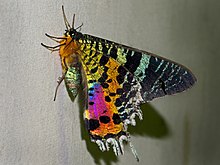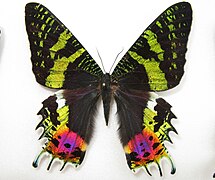Chrysiridia rhipheus
| Chrysiridia rhipheus | ||||||||||||
|---|---|---|---|---|---|---|---|---|---|---|---|---|

Chrysiridia rhipheus |
||||||||||||
| Systematics | ||||||||||||
|
||||||||||||
| Scientific name | ||||||||||||
| Chrysiridia rhipheus | ||||||||||||
| ( Drury , 1773) |
Chrysiridia rhipheus , sometimes referred to as "rainbow butterfly" or "Madagascar sunset moth" is an endemic in Madagascar occurring butterfly ( moth ) from the superfamily of geometroidea .
Taxonomy
Since the moths fly mostly during the day and have tails on the hind wings, the first descriptor Dru Drury assumed in 1773 that the species was a member of the butterfly genus Papilio and named it Papilio rhipheus . Only Jacob Hübner presented the way in 1823 to the moths and gave her the name used today Chrysiridia rhipheus . There are also some junior synonyms , including: Urania druryi , Urania papageno , Urania rhipheus , Urania ripheus and Chrysiridia madagascariensis .
features
butterfly
The wingspan of the moth is 70 to 90 millimeters. The basic color of the wings is deep black and on the upper side of the fore wing there are strongly iridescent , mostly greenish-brownish shiny stripes. The upper side of the hind wing shimmers in all tones that the color spectrum contains, especially near the anal angle . This coloring does not appear due to pigmentation , but due to the special surface structure of the wing scales , through which the light is refracted in a wide variety of ways. This makes the moths one of the most colorful of all butterflies. The outer edge of the hind wing has six tails of different lengths with white fringes. The undersides of the wings are similar to the upper sides in terms of design and color, but tend to have more turquoise and orange tones depending on the incidence of light.
Caterpillar
The caterpillar is creamy white in color, black behind the head and more or less blackish spots on the rest of the body. The entire surface of the body is provided with individual bristle hairs that are thickened in the shape of a club at the end. Large black spots stand out from the brown head.
Distribution and occurrence
The species is found only on the island of Madagascar. She prefers to inhabit tropical forests there.
Way of life
The moths of Chrysiridia rhipheus are diurnal, fly until sunset (English name: Madagascan sunset moth or Madagascar sunset moth ) and have a polyvoltine generation sequence . Sometimes they fly long distances to develop new habitats. The caterpillars feed on the flowers and leaves of the genus Omphalea, which belongs to the milkweed family (Euphorbiaceae) . These contain toxins that are stored in the caterpillars, pupae and butterflies, making them inedible for potential predators. The conspicuous coloring of the moths is primarily to be understood as aposematism .
Danger
Due to the great attractiveness of the moths in terms of color, a considerable number of collectors and dealers took them from nature at times and their existence was therefore endangered. After the trade in the species was banned, the populations recovered. The destruction of their natural habitat (tropical forests) through slash and burn or the creation of palm oil plantations is proving to be a new threat.
Individual evidence
- ↑ Shinya Yoshioka & Shuichi Kinoshita: Polarization-sensitive color mixing in the wing of the Madagascan sunset moth , Optical Society of America, Vol. 15, No. 5, 2007
- ↑ occurrence
- ↑ Rainbow butterfly in the Stuttgart Natural History Museum
Web links
- eol.org - Encyclopedia of Life



